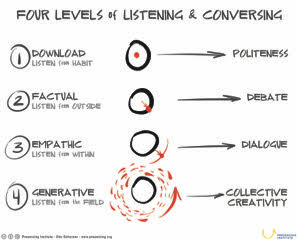Convene a multi-stakeholder team
To successfully gain traction on a complex challenge, you and your team need to join together with representatives from different parts of the system to:
- Share your perspectives
- Form a picture of the whole
- Create a vision of a possible future
But convening people from distinct sectors, cultures, organizations, and functional areas isn’t as easy as simply calling a meeting. It requires:
- Clarifying the boundaries of the system
- Identifying the stakeholders
- Developing awareness of the power dynamics in the system
- Extending an invitation that piques people’s interest
- Gaining commitment to the project and process
Once a team has assembled, you need to create a context in which participants feel safe engaging authentically and openly. It’s also vital for people to get to know each other on a human level and not just as representatives of one part of the overall puzzle. Group members must build shared trust and mutual understanding, while at the same time setting aside defensiveness and judgment.
All of this may sound like a tall order—and it is. But the effort you collectively spend creating the context for engagement will pay off over time in the quality of the outcomes you achieve.
Send us your recommendations for practices and tools.
Check-In
The Check-In is a simple practice that contributes to creating a context—or “container”—in which participants feel safe engaging with others authentically and openly. At the start of each meeting, participants take turns briefly sharing what’s on their minds in that moment. The process helps people to be fully present by letting them voice any concerns or issues that might otherwise distract them. It also builds relationships by allowing participants see each other as whole people and not just as the roles they play. And it gives everyone “a sense of the room”—people’s overall moods, concerns, and energy.
“How to Start a Meeting” by Kristin Cobble
“Check-in Check-out”
The Check-In by Flip the Clinic
The “Check-In” as a Tool for Co-Sensing
Stakeholder Interviews
According to the Presencing Institute, “Stakeholder Interviews are conducted by practitioners with their key stakeholders: this could include customers, bosses, subordinates, or peers both within and outside the organization. The interviews allow you to step into the shoes of your interviewees and see your role through the eyes of these stakeholders.” Through the process, you also deepen your relationship with these individuals.
Stakeholder Interviews
Presencing Tools and Practices
Theory U, a framework and method for leading profound change developed by Otto Scharmer, offers perspectives and practices for tapping into the wisdom and experiences of others. By opening ourselves to engaging with people in new ways, we “initiate a generative dialogue that allows for reflection, thinking together, and some sparks of collective creativity to happen.” Here are two practices and tools based on this powerful approach to “leading from the future”:
Four Levels of Listening: According to Scharmer, there are four levels of listening: Downloading, Factual Listening, Empathic Listening, and Generative Listening. By deepening the way you listen to others, you can better connect with what is going on now and with what is possible in the future.

Otto Scharmer on the four levels of listening
Dialogue Interviews
Dialogue Interviews are a tool for gathering perspectives and sensing what’s going on from people from throughout a complex system. Reos Partners, a global consulting firm that uses this technique, describes them in this way: “Dialogue Interviews are in-depth conversations with concerned people throughout a complex system. Rarely do people feel so thoroughly heard. After conducting these conversations, we synthesize them and mirror them back, identifying common threads. The result is an unusually candid, reflective, and holistic assessment of the problem.”
Dialogue Interviews
4-Player Model
Systems psychologist and consultant David Kantor contends that there are four different roles people play in any conversation: Mover, Follower, Bystander, and Opposer. In a productive conversation, people shift roles without becoming stuck in one, and the group as a whole maintains a healthy balance among the four perspectives. The Four-Player Model is useful for ensuring this balance.
4-Player Model
Stakeholder Analysis
Stakeholder Analysis is a technique for identifying the key people affected by any initiative. For the initiative to be successful, you then need to build the support you need from different constituencies.
Stakeholder Analysis
The World Café
The World Café methodology is a format for engaging people in conversations that matter. Using seven design principles and a simple method, it is “a natural and effective way to host meaningful conversations that awaken collective wisdom and engage collaborative action.” The World Café is based on the premise that conversation is the core process that drives personal, business, and organizational life. As people move from group to group during a World Café event, the natural cross-pollination of relationships, ideas, and meaning enables people to learn, explore possibilities, and co-create together.
The World Café